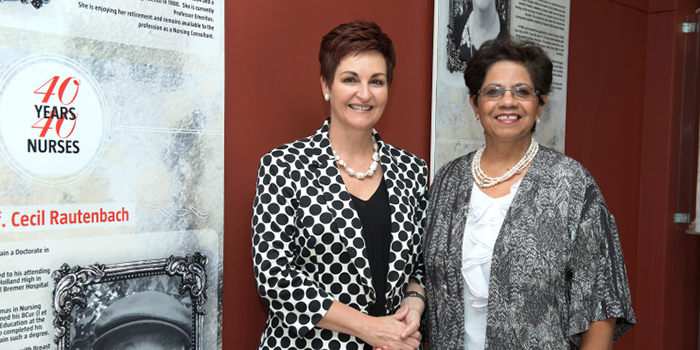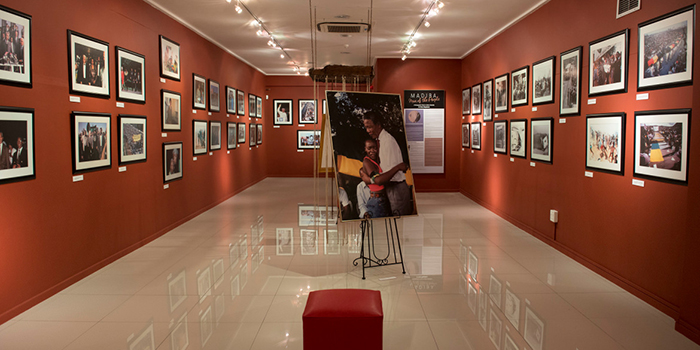40 Years 40 Nurses


This exhibition celebrates the University’s Department of Nursing Science’s 40th birthday - telling the life stories of 40 devoted nursing graduates, many of whom maintain strong links with the university.
The Univeristy itself turns 10 this year, but its history goes back much further, as it was formed in 2005 from a merging of the former University of Port Elizabeth (UPE), Port Elizabeth Technikon and Vista University’s Port Elizabeth campus. The Department of Nursing Science was established in 1975 at UPE.
This “40 years, 40 nurses” exhibition features attractive ceiling-high panels, which pay homage to the nurses, outlining where they came from, why they chose nursing, where their careers have taken them, and how they have made an impact, locally, nationally and internationally.
Among the 40 are nursing stalwarts like Prof Nita Strumpher, who has spent 37 years teaching at the university. Ironically, she chose to study nursing on a whim, following friends who were planning to do the same, but soon discovered nursing was her calling in life.
Some of the nurses profiled have made history, like Dr Jill von der Marwitz, who was instrumental in establishing South Africa’s first on-campus Anti-retroviral (ARV) Clinic, at the University. There is also Prof Cecil Rautenbach, who was the first male nurse in the country to obtain a Doctorate in Nursing.
Some nurses have emigrated or worked elsewhere, blazing a trail of success in other countries - like Prof Cheryl Benn, who has headed up various programmes and committees in New Zealand, including being appointed to the Nursing Council of New Zealand by the former Minister of Health.
Also in the mix is current Head of Department Prof Esmeralda Ricks, who is passionate about researching how mobile technology can be used to enhance community nursing, along with past head Prof Dalena van Rooyen, who is now director of the University's School of Clinical Care Science, and part of the team working towards the University's goal of building a medical school by 2020.
The department has indeed come a long way since it first opened its doors in 1975, with just six undergraduate and 18 postgraduate students. Last year, there were 456 undergraduates and 279 postgraduates.
Many are attracted by the department’s world-class simulation laboratories, which house state-of-the-art equipment for the various nursing disciplines, enabling students to practice their clinical skills in a safe environment, before working with patients. The University has conducted simulation training workshops throughout South Africa and in Zambia and the Democratic Republic of Congo.
The department has strong international ties with the United States, Norway, Sweden and India, and plays an active role in the various national nursing bodies.
At a local level, community engagement is a priority. Staff members are involved in the training of nursing educators at Lilitha College of Nursing, and selected undergraduates assist on the Phelophepa train, which provides primary health care deep in deep rural areas.
The Department of Nursing has made an impact on health care education in general, and nursing science in particular, at a global, national and local level, and aims to continue to grow in excellence and build on their strengths - seeking to be innovative and visionary in teaching, engagement and research.
Madiba – “Man of the People” by Dr Peter Magubane


This unique exhibition features photographs of the country’s best-loved former leader, Nelson Mandela, by one of its best-known photojournalists, Dr Peter Magubane and is a fitting way to mark the 10th anniversary of the only university that bears Mandela’s name.
"This is our country’s history. These are the things that Madiba and so many others were jailed for ... Madiba made great sacrifices for us all. We must never forget that,” said Magubane, 83, who on Saturday (4 July) received the 2015 Nat Nakasa award for his courageous photojournalism during apartheid, jointly awarded by the South African National Editors Forum (SANEF), the Nieman Society and Print Media South Africa
Magubane – who first photographed Mandela in the 1950s, later visited him on Robben Island and was waiting outside Victor Verster Prison on the day of his release – was the former statesman’s official photographer from 1990 to 1994, when he was elected as President.
In this role, he chronicled the first few years of Mandela’s freedom, and the last part of South Africa’s long journey towards democracy. He travelled the world at Mandela’s side, photographing him with royalty and heads of states, but also saw him relaxing at home with his family, capturing quieter, more intimate moments rarely seen by the world.
Magubane turned these photographs – together with powerful images from pivotal struggle events like Sharpeville and the 1976 Soweto riots – into the book Man of the People: A photographic tribute to Nelson Mandela book.
And it is this book, Magubane’s personal tribute to his friend Mandela, which has provided the inspiration, and the photographs for this exhibition.
Quoted in his book, Magubane says: “[Y]ou will find pictures of Mandela being serious and then he is holding a baby; at other times he is jiving and dancing. This is the man who most white South Africans thought might be different. Instead of confirming their worst fears of pushing them out of the country, he offered hands of peace, saying: ‘Come, let’s work together, let’s build this country together.’”
Photos from “the early years” (when Mandela was a rising politician), “the struggle years” and “the freedom years” are to be seen in this exhibition.
Magubane first worked at Drum in the 1950s – and was the first black photographer to win a prize for press photography in South Africa. He later worked for the Rand Daily Mail and Time magazine South Africa.
He was arrested several times, and endured 586 days in solitary confinement, along with a five-year banning from 1970 to 1975.
Awarding Magubane an Order for Meritorious Service in 1999, Mandela said the stories Magubane told through his photographs “helped pave the way to transformation in South Africa”.